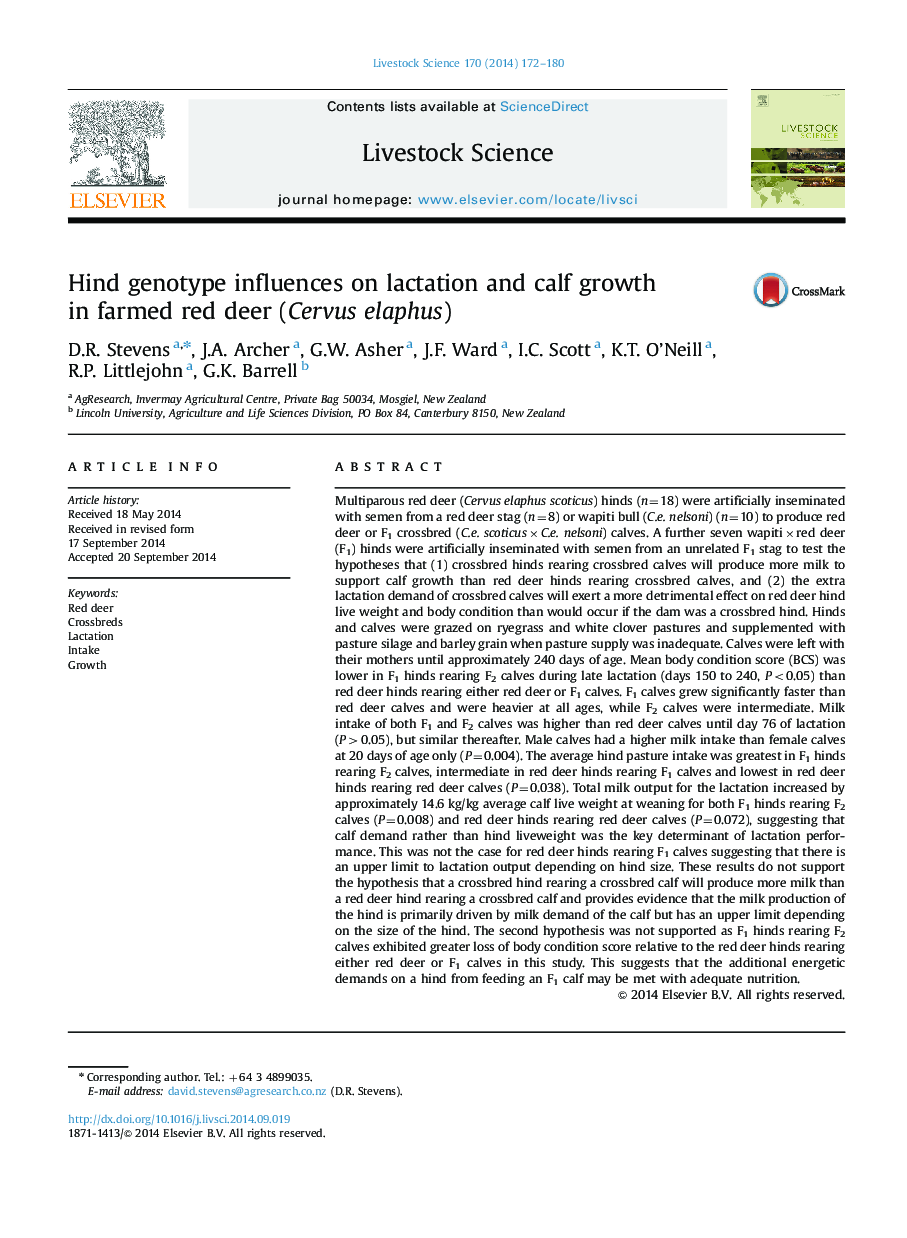| کد مقاله | کد نشریه | سال انتشار | مقاله انگلیسی | نسخه تمام متن |
|---|---|---|---|---|
| 2447179 | 1553962 | 2014 | 9 صفحه PDF | دانلود رایگان |

• This study investigated the effect of maternal genotype on lactation and calf growth in red deer (Cervus elaphus ssp. scoticus and nelsoni).
• The study showed that the milk production of the hind is primarily driven by milk demand of the calf.
• Crossbred hinds rearing crossbred calves showed greater loss of body condition than red deer hinds rearing either red deer or crossbred calves.
• This suggests that the additional energetic demands on a hind from feeding a crossbred calf may be met with adequate nutrition.
Multiparous red deer (Cervus elaphus scoticus) hinds (n=18) were artificially inseminated with semen from a red deer stag (n=8) or wapiti bull (C.e. nelsoni) (n=10) to produce red deer or F1 crossbred (C.e. scoticus×C.e. nelsoni) calves. A further seven wapiti×red deer (F1) hinds were artificially inseminated with semen from an unrelated F1 stag to test the hypotheses that (1) crossbred hinds rearing crossbred calves will produce more milk to support calf growth than red deer hinds rearing crossbred calves, and (2) the extra lactation demand of crossbred calves will exert a more detrimental effect on red deer hind live weight and body condition than would occur if the dam was a crossbred hind. Hinds and calves were grazed on ryegrass and white clover pastures and supplemented with pasture silage and barley grain when pasture supply was inadequate. Calves were left with their mothers until approximately 240 days of age. Mean body condition score (BCS) was lower in F1 hinds rearing F2 calves during late lactation (days 150 to 240, P<0.05) than red deer hinds rearing either red deer or F1 calves. F1 calves grew significantly faster than red deer calves and were heavier at all ages, while F2 calves were intermediate. Milk intake of both F1 and F2 calves was higher than red deer calves until day 76 of lactation (P>0.05), but similar thereafter. Male calves had a higher milk intake than female calves at 20 days of age only (P=0.004). The average hind pasture intake was greatest in F1 hinds rearing F2 calves, intermediate in red deer hinds rearing F1 calves and lowest in red deer hinds rearing red deer calves (P=0.038). Total milk output for the lactation increased by approximately 14.6 kg/kg average calf live weight at weaning for both F1 hinds rearing F2 calves (P=0.008) and red deer hinds rearing red deer calves (P=0.072), suggesting that calf demand rather than hind liveweight was the key determinant of lactation performance. This was not the case for red deer hinds rearing F1 calves suggesting that there is an upper limit to lactation output depending on hind size. These results do not support the hypothesis that a crossbred hind rearing a crossbred calf will produce more milk than a red deer hind rearing a crossbred calf and provides evidence that the milk production of the hind is primarily driven by milk demand of the calf but has an upper limit depending on the size of the hind. The second hypothesis was not supported as F1 hinds rearing F2 calves exhibited greater loss of body condition score relative to the red deer hinds rearing either red deer or F1 calves in this study. This suggests that the additional energetic demands on a hind from feeding an F1 calf may be met with adequate nutrition.
Journal: Livestock Science - Volume 170, December 2014, Pages 172–180